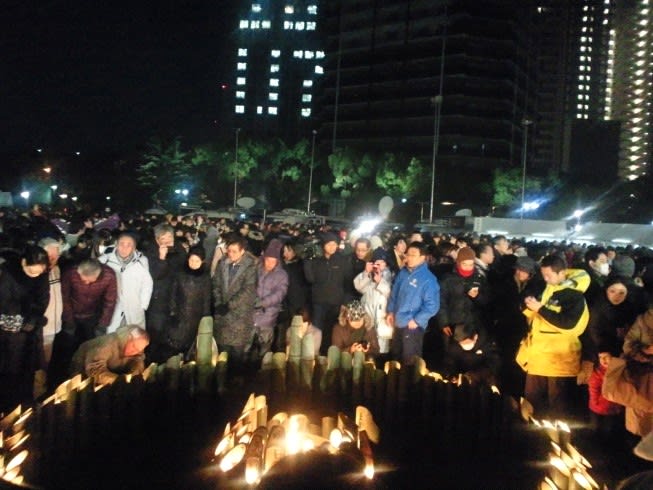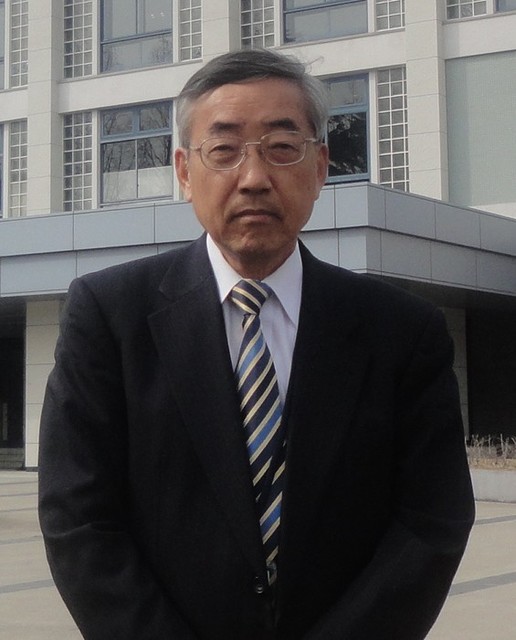阪神大震災20年 震災体験をどう語り継ぐか
毎年1月17日、神戸市東遊園地で行われる追悼行事で、その会場に設けられ、“シンボル”となっている「竹灯篭」の行事を担っていたボランティア団体「神戸・市民交流会」が高齢化のために解散を決めたという。(追悼の灯が岐路 高齢化で解散の意向 朝日新聞 2015年4月23日)
毎年、約1万本の竹灯篭を作製し、ろうそくも約2万個手作りしていたという。来年からは市内のNPO法人が引き継ぐという。
筆者は、20年目を迎えた今年、追行行事に参加し、“思い”を新たにした。以下は、そのその直後に掲載した原稿だが、再掲したい。
2015年4月23日


阪神大震災20年
~震災報道担当者からのメッセージ~
■ 阪神大震災 20年目の追悼行事
1995年1月17日、未明の5時46分、阪神・淡路地方を襲った巨大地震は、一瞬で神戸の街を破壊した。死者6434名、全半壊家屋24万9180棟、約千か所の避難所に避難した人30万人以上、未曽有の大災害だった。
あれから20年、あっと間の歳月である。
20年目の節目の年である今年、筆者は、犠牲者の追悼行事に参加するために、1月17日、久しぶりに神戸市を訪れた。
まだ暗闇の5時過ぎ、神戸市のJR三宮駅は、東遊園地で開催される追悼イベントの参加する人々で大混雑だった。駅から会場に向かう歩道は、親子連れ、夫婦、若者や高齢者のグループで、延々行列が続いていた。
会場の東遊園地は、5時過ぎには、日の出前の暗闇の中、すでに参加者で立錐の余地もないほど埋っていた。神戸市の係員は、「こんなに参加者がくるとは思ってもいなかった。20年経っても震災は風化していないですね」と話していた。
黙祷に入る前に、会場に流されたアナウンスが心にしみた。
「震災で失ったもの。命、仕事、団らん、街並み、思い出。震災が残したもの。優しさ、思いやり、絆、仲間。」
5時46分、時報と共に、参加者全員が黙とうした。
東遊園地の隣にある関西電力の本社ビルには、「20 1.17」の文字が、浮かびあがっていた。
20代の男女の若者の参加者もたくさん見かけた。20年前、震災が発生した時は、まだ幼い子供で、両親が懸命に、命を、暮らしを守ってくれたのに違いない。中には、親が震災の犠牲となった人もいると思われる。
東遊園地の一角にある献花台は、大勢の参拝者で長蛇の列だった。
献花台の下には、震災の6,434人の犠牲者の氏名が刻まれたプレートが壁面一杯に並べられている。
「ほら、ここに名前がある。つらかったよね」、犠牲になった肉親の氏名のプレートを指でさすりながら手を合わせる人に何人も会った。
■ 震災報道
筆者は、阪神大震災が発生した1995年、NHK大阪放送局勤務で、報道番組の責任者だった。
震災発生から、ほとんど不眠不休で、大阪放送局に寝泊まりした震災報道にあった。発生から136時間、絶え間なく続けた震災関連ニュースや情報番組、そしてクローズアップ現代やNHKスペシャルなどのドキュメンタリー、特集番組、避難所情報、電気・ガス・救援物資などの生活情報、安否情報、NHKのテレビやラジオを総動員して、無我夢中で、やれることは何でもやった。
とりわけ安否情報については、特別チームを組み、NHKとしては初めて本格的に取り組んだ。
震災報道を担当した一人として、20年経った今でも頭にこびりついていることが3つある。
■ 初動情報の重要性
その一つは、大災害発生時の「初動情報」である。
大災害発生時の災害情報の伝え方の最大の問題は、「初動」である。
大災害であればあるほど、被災地からの情報が途絶し、被災地で何が起きたのか、今、どんな状況にあるのか、現場はどこなのか、災、害の規模はといった情報が伝わってこない。
とりわけ災害の規模感は、重要で、国が初動体制を組む時に必須な情報である。官邸、防災関連官庁、警察、消防、自衛隊、一刻も早く体制を動かさなければならない。事態は一刻を争う。被災者の命がかかっている。
阪神大震災の場合、わずか10kmしか離れていない大阪では、かなり揺れたが、被害が起きるほどではなかった。地震が発生すると、NHKではニュース速報を放送するが、初動は気象庁発表の震度情報と津波警報、注意報主な情報だ。巨大地震に阪神地域が襲われたことは分かっていたが、一体どこに地域でどんな被害が出ているのかまったく情報がない。発生後、数時間は、「大阪市内で倒れた家具でお年寄りがけがをした」とか「石塀が倒れた」といったニュースを繰り返し流していた記憶がある。
一方、壊滅的な被害を受けていた神戸からの被災情報は、「初動」では、ニュースを送出する大阪局ニュースに伝わって来なかった。神戸のニュース拠点、NHK神戸放送局が被災し、電気、電話、通信が途絶していた。
電話で取材しようにも電話は不通、取材車は使用できない、かろうじてNHK神戸放送局の周辺の被災状況は伝えられたが、神戸市全体がどうなっているのかまったくわからない。地震発生が未明だったこともあり、局内にいる要員は数人しかいない。大地震発生で、局に駆けつけるスタッフも、自らが被災者で家族の安全確保に奔走しなければならなかったり、道路が崩壊しているために自宅から駆け付けるまでに時間がかかったりして、取材体制の立ち上げには時間がかかる。
もどかしい時間がむなしく過ぎて行った。
災害報道のもっとも重要なポイントは「初動」である。一刻も早く、災害の規模、状況を伝えて、住民や国・地方自治体、関係諸機関などに「初動」の立ち上げに必要な情報を提供することである。消防や警察、防災機関の災害情報とは違って、全国の視聴者に、瞬時に災害情報が伝達可能で、そのパワーは絶大である。
こうした膠着状況を一気に打開したのは、8時過ぎに伊丹空港を飛び立ったNHKの生中継ヘリコプターだった。
午前8時49分のNHKの臨時ニュース。
息を飲むすさましい光景がカメラに写し出された。
神戸市内のあちこちから立ち上る黒煙と炎、倒壊した阪神高速道路、倒壊した建物、壊滅した住宅街。
初めて巨大地震に襲われた被災地「神戸」の姿だった。
この映像に衝撃を受けた、政府、防災関連省庁、近隣自治体、全国各地の警察、消防、自衛隊、そして企業、一気に動き始めたのである。
阪神大震災をきっかに、大災害時に、災害の全体状況、規模感をどう素早く、的確に把握するかは、その後の災害対策本部の立ち上げ、救命救助の広域応援体制や医療・物資・食糧などの広域支援体制など「初動」体制をどう始動させるかに係る、極めて重要な要件である。大災害発生時の危機管理体制が整えられ始めのは阪神大震災がきっかけだった。。
緊急消防援助隊(消防)や広域緊急援助隊(警察)や、最近テレビドラマでも取り上げられている災害派遣医療チーム(DMAT)が創設されたのもその一環である。
■ 地域コミュニティの防災力
2つ目は、地域コミュニティの防災力である
10年前、NHK総合テレビで「難問解決!ご近所の底力」というユニークな番組を放送していた。
問題を抱えている町内会・自治会の代表(お困りご近所)20人がスタジオに登場し、以前同じような問題を抱えていた町内会・自治会の解決法を参考に問題を解決していくという内容である。「ごみ問題」「駐車問題」「防犯」「防災」さらに「町おこし」などのテーマを取り上げ、「ご近所の底力」で「難問解決」に知恵を出すという番組だ。
大都会では、隣近所のコミュニティが崩壊したと言われてから久しい。
阪神大震災では、その「ご近所の底力」が命を救ったという被災者の証言を頻繁に聞いた。
「隣のおばあちゃんが見当たらない。おばあちゃんはいつも1階の台所の隣に寝ていた」「よしそこを掘り起こそう」
倒壊家屋の下敷きになった被災者のかなりの数は、地域コミュニティ・パワーで救われたという。警察、消防、自衛隊、駆けつけるまでに時間がかかる。大災害になればなるほど、全国から緊急支援体制に頼らざる得をない。阪神大震災の場合、広域支援チームが活動を始めたのは、1月17日の夕方から夜にかけてだった。猛烈な交通渋滞で緊急支援車は行く手を遮られていた。すでに発生から12時間以上過ぎていた。救命救助は時間勝負、「初動」の速さでは、地域コミュニティ・パワーにかなわない。
警察、消防、自衛隊には機動力はあるが、「あの家には、おばあちゃんの一人暮らしで、おばあちゃんはいつも1階の台所の隣に寝ていた」という地域コミュニティ・パワーの情報力はない。
昨年の広島土砂災害時の救命救助活動にも、どこの家に誰が、どのように暮らしていたのかという情報が非常に役立ったという。
東日本大震災の津波警報の住民の避難についても、テレビやラジオ、そして防災無線で、避難を呼びかけるのは勿論だが、結局、一番決定的なのは、隣の人の「おばちゃん、何も持たなくていいから、早く逃げよう」という一言なのでなないか。
■ なぜ助けられなかったのか
3つ目は、なぜ助けられなかったのか。“無念”の思いである。
阪神大震災で最も多くの犠牲者を出した神戸市長田区菅原地区。
昔ながらの木造住宅の多い商店街だった。この地区の家屋はほとんどが倒壊し、多くの被災者が、倒壊した家具や、柱、壁、天井の下敷きになり、閉じこ められた。負傷はしていたと思われるが、まだ一命はとりとめていた。
倒壊した木造家屋は、火災に極めて弱い。一度火がつくと、あっという間に延焼し、大火となってしまう。長田区は震災発生後の大火に見舞われた。
1月17日午前7時、震災発生から約2時間、建物火災は神戸市全体で63件、これに対して神戸市の消防車は40台、消防隊は29チーム、消防隊が初動の消火活動で駆けつけた火災現場は半分で、半分は、燃え盛るままだったと思われる。神戸市の消防能力を完全に上回る災害であった。
長田区は、古い木造家屋が多く、地震での倒壊率も高くて、大きな被害を受けていた。神戸市内のいたる所で発生した火災の消火活動に追われて、消防車が駆け付けた火災現場は、長田町では半分以下だったと想定されている。
初動に消火活動は、長田区の消防団や町内会に頼らざるを得なかった。
しかし、倒壊木造家屋は、出火すると火の回りは極めて早い。
防火水槽は瞬く間に空っぽ、消火栓は地震の被害で水は出なかった。
猛烈な火の手に、長田町の人たちはなすすべがなかった。
夕方から夜にかけて応援の消防車が到着して消火活動が始まる。しかし、すでに防火水槽は空っぽ、地域の学校のプールの水も瞬く間になくなり、消火栓は地震の被害で使用できない。燃え盛る炎を前に、消防隊員も茫然と立ち尽くす他はなかった。
倒壊家屋に閉じこめられた被災者を救助する警察、機動隊などの救助隊もほとんど手が回らなかった。命を守ったのは地元の人たちで、懸命に救出活動を行い、救助された被災者も多かったと聞く。
しかし、あまりにも被災した住宅が多く、重機もないので、作業は進まない。
「おとうさん、もういいから逃げて」
猛烈な火の手がすぐそばまで迫っている中で、倒壊した家屋の瓦礫に閉じこめられた被災者が、懸命に助けようとしていた夫に、最後に叫んだ一言である。
同じ話をあちこちで耳にした。
まさに凄惨な光景である。
地震の一撃で、亡くなった犠牲者も多いが、なんとか一命をとりとめて救助を待っていた被災者が閉じこめられた倒壊家屋ごと、焼き尽くされ、犠牲になったケースもかなりあったことが明らかになっている。
長田区の消火活動は、その後、続々と到着する消防車が加わり、消火用の水を、神戸港からポンプ車を7台も連結し、ホースを100本余り使用して海水を送水して行われた。海から延々引かれたホースは、あちこちで通行車両に踏まれて破裂し、その交換に奔走しながらの消火活動だった。
広域緊急消防体制の問題も、阪神大震災を契機に浮上した。
各地から応援に来た消防車のホースの径が、各都道府県によって異なり、連結ができなかった。また消防防災無線が1波しかなく、混信や輻輳で、大混乱した。またヘリコプターを使用しての消火活動の可能性など、防災体制の強化に向けて改善の動きが始まっている。
■ 「ボランティア元年」
「ボランティア元年」、いつしか、阪神大震災はこう呼ばれるようになった。
全国各地から高校生、大学生、社会人、主婦など、1日2万人、発生から1年間で延べ138万人が被災者の支援に訪れた。
阪神大震災発生直後にできた避難所は1000か所、30万人を超える被災者が避難した。これに対し、神戸市の職員は約3000人、一人一人の被災者の支援には、とうてい手が回らないだろう。
市内各地の避難所に張り付き、被災者の支援を担ったのは、ボランティアだった。
「ボランティア元年」の流れは、その後、東日本大震災に見事に引き継がれた。
筆者は、取材で行った避難所で、「ご苦労さま。寒いでしょう。これで温まって下さい」とボランティアから炊き出しの「豚汁」をもらったことがある。
あの冬、神戸は寒かった。腹の中に熱い「豚汁」がしみた。
そして20年後、慰霊祭の会場となった神戸市東遊園地でも、ボランティアが「豚汁」の炊き出しを行っていた。長い列に並んで、「豚汁」をもらいあの日と同じように味わった。炊き出しは「豚汁」が定番である。
今年の「豚汁」は、野菜、豚肉、具たくさん、ふと20年前の「豚汁」を思い出した。具は、器の底に申し訳なさそうにあるだけで、ようは「みそ汁」、だけどうまかった。
東遊園地で毎年開催する追悼行事には、神戸市のボランティアの団体が灯篭の竹やろうそくを提供している。あれから20年、竹灯篭は、犠牲者への鎮魂の思いを込めて、今年も灯っていた。
■ 結び2011年3月11日、三陸地方を襲った巨大津波で、犠牲者1万8517人という戦後最悪の被害となった東日本大震災から、まもなく4年を迎える。
また昨年は、長野県北部地震、御嶽山噴火などが発生するなど日本列島の地殻変動は、確実に「活動期」を迎えているように思える。地球温暖化による気象変動の影響と考えられる巨大台風、集中豪雨が日本列島を次々と襲っている。
「防災力」という言葉を最近、よく耳にする。
国や地方自治体、防災関連機関では、危機管理体制を強化し、災害に強い“国”づくりを推進するのは、勿論のことが、「防災力」を高めるのは、私たち一人一人が果たす役割も大きいのではと痛感している。
震災から20年、震災報道に携わった一人として、果たして阪神大震災の報道は本当に被災者のためになったのか、復興に役立ったのかという自省の思いと6434人の犠牲者の魂への追悼の念を込めて、結びとしたい。
2015年2月1日
国際メディアサービスシステム研究所
代表 廣谷 徹
(元NHK報道番組プロデューサー)





















